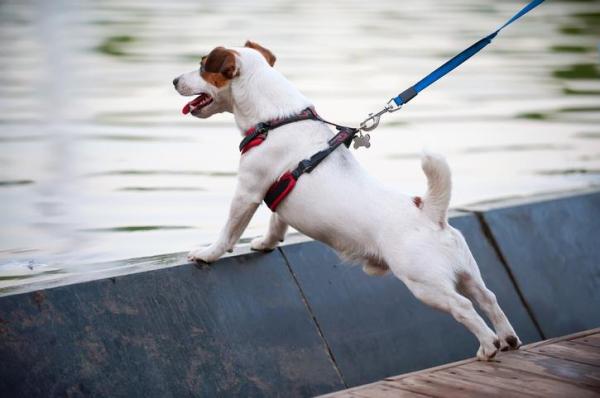How to Train Your Dog to Run With You



See files for Dogs
There's something magical about hitting the pavement or trail with your dog friend trotting happily beside you. Whether you're an experienced runner looking to bring your pup along or a dog parent hoping that a running routine might burn off some of your energetic companion's enthusiasm, this guide will help you build a successful running partnership. Every dog-human running team is unique, with its own pace, preferences, and challenges.
In this AnimalWised article, we'll teach you how to train your dog to run with you, and how to create a running routine perfectly tailored to both your needs.
Is your dog ready to run?
Ready to transform your daily jog into quality time with your dog? You're the expert on your furry friend, however, there are some things to consider as you decide if running together is right for both of you.
While puppies have endless enthusiasm, their developing bones need protection. Many vets suggest waiting until 12-18 months before starting regular runs, especially for larger breeds whose joints continue developing until about 2 years. You'll notice if your dog's build might make running challenging, whether it's your Dachshund's shorter stride or your Bulldog's breathing patterns during play. You decide what exercise works best based on what you observe.
A conversation with your vet provides valuable information as you plan your running routine. They can offer specific insights about your dog's individual needs or potential concerns. You'll make the call about how to incorporate their advice into the exercise program you create for your dog.
No one understands your dog's personality better than you do. When you notice your dog pacing, bringing toys constantly, or getting the "zoomies," you're recognizing signs they might thrive with more activity. Your observations of their energy patterns will guide you to the right exercise intensity.
Dogs like Labs, Border Collies, Vizslas, and Weimaraners often enjoy running, but you determine what activities suit your unique dog, regardless of breed or background. Your mixed-breed companion might discover a passion for trails, while your purebred might prefer gentler activities. You'll build your running relationship based on what brings both of you joy.
Running with your dog creates a positive feedback loop of well-being that extends far beyond the physical benefits. Uncover the surprising ways this shared activity transforms both your lives in our popular companion article.

What do I need to run with my dog?
The right gear makes all the difference when running with your four-legged partner. Here's what to consider as you prepare for your adventures together.
Proper leash and harness:
You'll want to choose a sturdy, non-elastic leash between 3-6 feet long, which gives you control while allowing your dog comfortable movement. Skip those retractable leashes for running, since they offer minimal control and can cause injuries when suddenly locked. For your dog's comfort and safety, select a harness rather than a collar for running. You'll notice a good harness distributes pressure across your dog's chest rather than their throat, reducing strain and giving you better directional control.
Hands-free running leash options:
Consider a hands-free leash that secures around your waist, freeing up your arms for natural running motion. These specialized leashes often include features you might appreciate, such as shock-absorbing bungees that reduce jarring when your dog changes direction, and quick-release mechanisms for safety. You'll determine which style works best based on your running environment and your dog's running style.
Collapsible water bowls:
Your dog needs hydration just as much as you do. Lightweight, collapsible water bowls can easily fit in your running pack or pocket. You'll learn to recognize your dog's hydration needs and it is important to plan water breaks every 15-20 minutes during warmer weather or longer runs. Some runners find dog-specific water bottles with built-in drinking trays more convenient.
Paw protection:
You'll be the best judge of whether your dog needs paw protection based on your running surfaces and local weather conditions. For hot pavement, rough trails, or icy conditions, consider dog booties or paw wax. Watch how your dog responds to different terrains, and you'll know when additional protection might enhance their comfort during your shared runs.
Struggling with a dog who turns your run into a drag session? Discover our proven techniques to transform leash pulling into pleasant side-by-side jogging in our companion training guide.

How do you train a dog to run alongside you?
Training your dog to become your running partner is a rewarding journey that strengthens your bond while building healthy habits. With patience and consistency, you'll develop a running routine that works for both of you.
Teach your dog to walk on a leash:
Before hitting running speeds, ensure your dog walks comfortably on leash without pulling. You'll find it much easier to run together when your dog already understands basic leash manners. Start in low-distraction environments where you can practice walking at your side.
If your dog pulls ahead, try changing direction or stopping briefly. That way, they'll quickly learn that pulling doesn't get them where they want to go. Some dogs respond well to front-clip harnesses that naturally discourage pulling by turning them toward you when they surge forward.
Build pace gradually:
Your dog will adapt best to running when you introduce it incrementally. Begin by adding short 30-second jogging intervals during your regular walks, returning to walking when you notice your dog getting distracted or tired. As you both build confidence, extend these running segments gradually. You'll recognize when your dog is ready for more based on their energy level after your sessions.
Some dogs adapt to running within weeks, while others might need months, you set the pace that works for your individual dog.
Teach running-specific commands:
Clear communication makes running safer and more enjoyable for both of you. Choose consistent commands that work for your team. Here are some examples:
- "Heel": reminds your dog to return to your side when they drift ahead.
- "Slow": signals a reduction in pace when approaching obstacles or turns.
- "Stop" or "Wait": for immediate halts at street crossings or when potential hazards appear.
- "Leave it": helps your dog ignore tempting distractions like squirrels or food scraps.
It is important to practice these commands first during walks, then during your jogging intervals.
Use positive reinforcement:
Your encouragement means everything to your dog. Reward desired behaviors immediately with whatever motivates your particular pup, whether that's small treats, enthusiastic praise, or a quick play session with a favorite toy.
Initially, you might pause briefly to deliver rewards, gradually transitioning to verbal praise while in motion. The positive associations your dog forms with running beside you will strengthen their desire to be your perfect running partner.
Keep early runs short and fun:
Finally, keep in mind that success comes from positive experiences. Your initial dedicated running sessions might last just 10-15 minutes, which is short enough to leave your dog wanting more rather than dreading the next outing.
End sessions while you're both still having fun, and vary your routes to keep things interesting. You'll build a running companion who associates your shared exercise with joy rather than obligation.
Want to take your dog training to the next level? Explore our comprehensive guide on positive reinforcement techniques that will strengthen your bond both on and off the running trail.

If you want to read similar articles to How to Train Your Dog to Run With You, we recommend you visit our Advanced education category.
- Barcelos, A. M., Kargas, N., Maltby, J., Hall, S., & Mills, D. S. (2020). A framework for understanding how activities associated with dog ownership relate to human well-being. Scientific Reports, 10, 11363. https://doi.org/10.1038/s41598-020-68446-9
- Barcelos, A. M., Kargas, N., Assheton, P., & Mills, D. S. (2023). Dog owner mental health is associated with dog behavioural problems, dog care and dog-facilitated social interaction: a prospective cohort study. Scientific Reports, 13, 21734. https://doi.org/10.1038/s41598-023-48731-z
- Powell, L., Edwards, K. M., McGreevy, P., Bauman, A., Podberscek, A., Neilly, B., Sherrington, C., & Stamatakis, E. (2019). Companion dog acquisition and mental well-being: a community-based three-arm controlled study. BMC Public Health, 19, 1428. https://doi.org/10.1186/s12889-019-7770-5
- Sundman, A. S., Van Poucke, E., Svensson Holm, A. C., Faresjö, Å., Theodorsson, E., Jensen, P., & Roth, L. S. (2019). Long-term stress levels are synchronized in dogs and their owners. Scientific Reports, 9(1), 1–7. https://doi.org/10.1038/s41598-019-43851-x
- Westgarth, C., Christley, R. M., Jewell, C., German, A. J., Boddy, L. M., & Christian, H. E. (2019). Dog owners are more likely to meet physical activity guidelines than people without a dog: An investigation of the association between dog ownership and physical activity levels in a UK community. Scientific Reports, 9, 5704. https://doi.org/10.1038/s41598-019-41254-6








